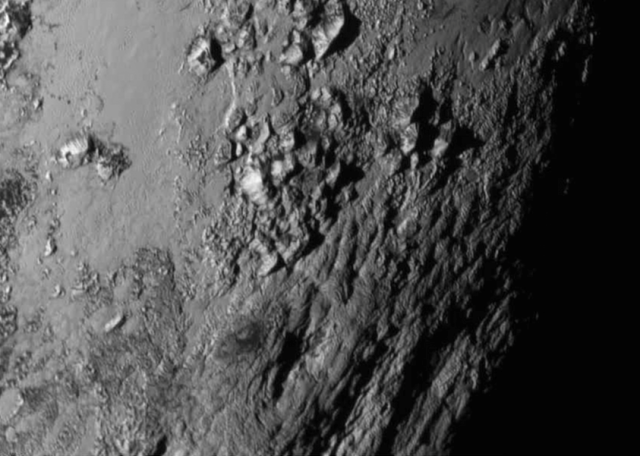- Back to Home »
- space »
- Pluto and Charon
Posted by : Koshime
Friday, 17 July 2015
PLUTO & CHARON
Updated: July 18th 2015
Plutos Mysterious Icy Region
Pluto contains a mysterious range of 11,000-foot mountains composed of frozen water ice, but its surface and the surface of its largest moon, Charon, are surprisingly devoid of large impact craters. This indicates to scientists that both bodies could be geologically active.
As Pluto and Charon are tidally locked, this implies there is an inadequate heat exchange mechanism to explain such geological features. Thus Pluto may be quite young, est 100 million years old, geologically active or have another unknown source of such featureless plains
Meanwhile, New Horizons also imaged the smaller moons of Nix, Hydra, Styx, and Kerberos

Pluto has some amazing geographical and planetary features
- Geologically, appears powered by unknown mystery source. Due to the fact no impact craters are seen, it must be geologically active or fairly young eg 100 million years old
- Nitrogen atmosphere
- Contains a Plasma tail (similar to Venus and Mars) showing solar wind interaction and atmospheric loss rate
Mystery Energy Source
July 18th 2015 update
"They have surface areas that have no craters. There must be craters [from meteorite impacts] unless they are young. We also see fault lines, scarps [cliffs] and other tectonic features such as rift valleys on both Pluto and Charon. It is unmistakable.""Where does the energy come from? We don't know. We have theories. We flew by Pluto on Tuesday [14 July]. We made the discovery on Thursday and now it's Saturday. We just don't know and we cannot formulate theories that fast."Pluto is covered in a deep layer of water ice which, frozen by the planet's -230C surface temperature, behaves like rock.Source: The Sunday Times
The Heart Of Pluto (Tombaugh Regio)
Within this icy region, lies a vast, craterless plain that appears to be no more than 100 million years old. North of this region lies the Sputnik Planum (sputnik plain). Below is a simulated flyover showing the icy details and new wonders
17th Jul 2015
This simulated flyover of Pluto’s Norgay Montes (Norgay Mountains) and Sputnik Planum (Sputnik Plain) was created from New Horizons closest-approach images. Norgay Montes have been informally named for Tenzing Norgay, one of the first two humans to reach the summit of Mount Everest. Sputnik Planum is informally named for Earth’s first artificial satellite. The images were acquired by the Long Range Reconnaissance Imager (LORRI) on July 14 from a distance of 48,000 miles (77,000 kilometers)
PLUTO NITROGEN ATMOSPHERE & PLASMA TAIL
14th July 2015
Cold, Dense Region of Atmospheric Ions Behind Pluto
the Solar Wind Around Pluto (SWAP) instrument observed a cavity in the solar wind — the outflow of electrically charged particles from the Sun — between 48,000 miles (77,000 km) and 68,000 miles (109,000 km) downstream of Pluto. SWAP data revealed this cavity to be populated with nitrogen ions forming a “plasma tail” of undetermined structure and length extending behind the planetSource: JHUAPL
CHARONs Mysterious Depressed Mountain

A newly released Charon photo, which was taken by NASA's New Horizons probe during its epic Pluto flyby Tuesday (July 14), reveals a mountain rising out of a big hole on the 750-mile-wide (1,200 kilometers) moon's surface.
The feature, which is visible at the upper left-hand corner of the inset, is "a large mountain sitting in a moat," Jeff Moore, of NASA’s Ames Research Center in Moffett Field, California, said in a statement.















